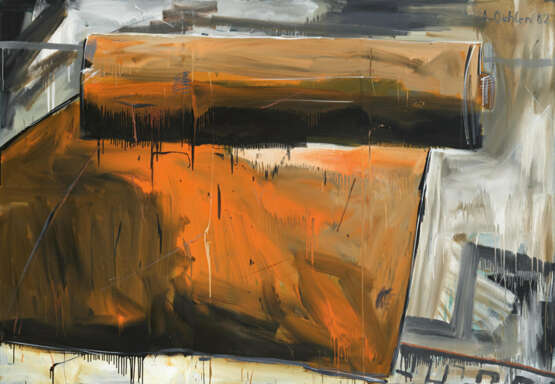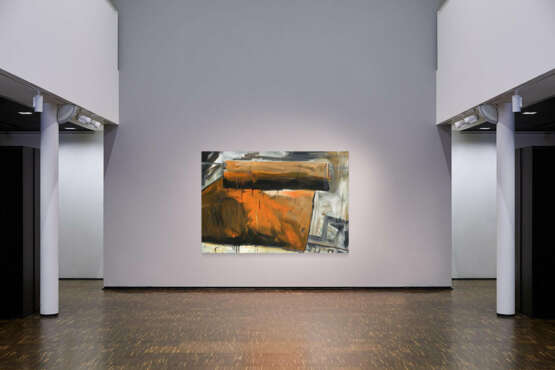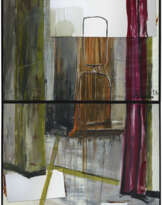ID 1406020
Lot 180 | Albert Oehlen. Teppich
Estimate value
€ 250 000 – 400 000
1954 Krefeld
Title: Teppich.
Date: 1982.
Technique: Oil and lacquer on canvas.
Measurement: 180 x 260cm.
Notation: Signed and dated upper right: A. Oehlen 82.
Provenance:
- Galerie Ascan Crone, Hamburg (label)
- Galerie Max Hetzler, Cologne (label)
- Bayer Inc., USA
- Bayer AG, Leverkusen (acquired from the previous owner in 2005)
Exhibitions:
- Martin-Gropius-Bau, Berlin 2013
Literature:
- Farbenfabriken Bayer (publisher): Kunstwerk - Bildende Kunst bei Bayer, Leverkusen 1992, p. 169, fig.
- Miksche, Uta: Bayer Collection of Contemporary Art, Sewickly 1995, p. 83, fig.
- Exhib. cat. From Beckmann to Warhol, Art of the 20th and 21st Centuries - The Bayer Collection, Martin-Gropius-Bau, Cologne 2013, p. 234, fig.
- Early major work of the rebel painter of the 1980s
- Between Neoexpressionsim and Postmodernism
- The work captivates through its format and the raw painting style typical of Oehlen
Ein frühes Meisterwerk der "postgegenständlichen Malerei"
Das großformatige Bild "Teppich" von 1982 ist ein Frühwerk des Malers Albert Oehlen, das durch den Kontrast zwischen Rotzigkeit und Ambition besticht. Der besondere Neuanfang, dem sich Oehlen und seine Weggefährten, die an der Wende zwischen den 70er- und den 80er-Jahren als "Hetzler-Truppe" berüchtigten Künstler Werner Büttner, Georg Herold, Martin Kippenberger, Günther Förg und Hubert Kiecol stellen mussten, bestand in dem Dilemma, dass in der Kunst schon alles gesagt worden zu sein schien, die Provokationen alle schon erfolgt waren und es trotzdem mit der gebotenen Radikalität weitergehen musste. Es blieb nur noch die Form allein übrig, und mit der Form verband sich stets der Anspruch auf Schönheit und Wahrheit. "Wahrheit ist Arbeit" nannten Büttner, Kippenberger und Oehlen eine gemeinsame Ausstellung 1984 im Museum Folkwang in Essen. In einem Interview anlässlich der Ausstellung "Bi.Nationale" in der Kunsthalle Düsseldorf und dem Museum of Fine Arts in Boston 1988 äußerte sich Albert Oehlen: "Ich glaube, dass ein Bild Zeugnis von Überlegungen ist und dass es ein Einverständnis hervorrufen kann, so dass der Betrachter sagen kann: 'bravo, richtig gemacht.' (.) Ich versuche z. B. den Begriff 'Geschmiere' oder 'Scheiße' oder 'Unscharf' oder 'Nebel' dem Betrachter aufzudrängen." (Albert Oehlen in: Harten, Jürgen u.a. (Hrsg.): Bi-Nationale. Deutsche Kunst der späten 80er-Jahre, Köln 1988, S. 243).
Das Gemälde
Das Bild "Teppich" ist Teil einer Serie von Gemälden, die kleinbürgerliche Interieurs zum Thema haben und in denen Schönheit entsteht, indem nichts beschönigt wird. Alles wird in seiner Primitivität und Armseligkeit präsentiert. Die Malweise ist roh und direkt, die Farben sind auf den ersten Blick unangenehm, reflektieren aber die gesehene Umgebung recht genau. Der Kritiker Wilfried Dickhoff konstatierte: "Die Verantwortlichkeit der Malerei aber ist keine unmittelbar inhaltliche, diskursive oder gar ideologische, sondern eine der Form." (Dickhoff, Wilfried: "Das Zu-Grunde Gehen der Malerei", über Albert Oehlen (1987) in: Ders.: Nach dem Nihilismus. Für eine Kunst des Unmöglichen, Köln 2001, S. 388.
"Teppich" ist ein frühes Schlüsselwerk von Albert Oehlen, in dem sich sein persönlicher Stil bereits ausgeprägt hat, der zeigt, was der Künstler unter "postgegenständlicher Malerei" versteht. Sein Stil hat sich allen gängigen Kategorisierungen wie "Neue Wilde", "Postmoderne" usw. erfolgreich entzogen. Das Bild ist gleichzeitig als reine Malerei und als Darstellung eines heruntergekommenen Innenraums lesbar. Hinter seiner scheinbaren Armseligkeit wird eine Vielzahl an Assoziationen und Verweisen auf die Geschichte der avantgardistischen Kunst des 20. Jahrhunderts sichtbar. "Es ist kaum überraschend, dass Oehlens rohe Darstellung dieses Gegenstands - und indirekt der Weltanschauung der Klasse, die er symbolisiert - verstörend direkt, sogar provokativ ist. In seiner Monumentalität und Übertreibung deutet er auf eine lähmende Selbstgefälligkeit in großem Maßstab hin - die Selbstgefälligkeit einer Kultur, deren hervorstechendste Eigenschaft, so scheint es der Künstler anzudeuten, ihr Status als kulturelles Vakuum ist." (Miksche, Uta, Bayer Collection of Contemporary Art, Sewickly 1995, S. 61)
Albert Oehlen hatte von 1974 - 1981 an der Hamburger Hochschule für Bildende Kunst studiert - u. a. bei Sigmar Polke - und wurde selbst ein erfolgreicher Lehrer. Zu seinen Schülern gehört etwa der innovative Digitalkünstler Tim Berresheim. Das Gemälde stammt aus dem engsten Umfeld des Künstlers und wurde vom Vorbesitzer in der Galerie Max Hetzler in der Zeit erworben, als er der wichtigste Galerist des Künstlers war.
Kay Heymer.
| Artist: | Albert Oehlen (1954) |
|---|---|
| Auction house category: | Post War paintings, drawings, watercolours |
| Artist: | Albert Oehlen (1954) |
|---|---|
| Auction house category: | Post War paintings, drawings, watercolours |
| Address of auction |
VAN HAM Kunstauktionen GmbH Hitzelerstr. 2 50968 Köln Germany | ||||||||||||||
|---|---|---|---|---|---|---|---|---|---|---|---|---|---|---|---|
| Preview | |||||||||||||||
| Phone | +49 221 92586215 | ||||||||||||||
| Fax | +49 221 92 58 62 4 | ||||||||||||||
| Buyer Premium | 32% | ||||||||||||||
| Conditions of purchase | Conditions of purchase | ||||||||||||||
| Business hours | Business hours
|














